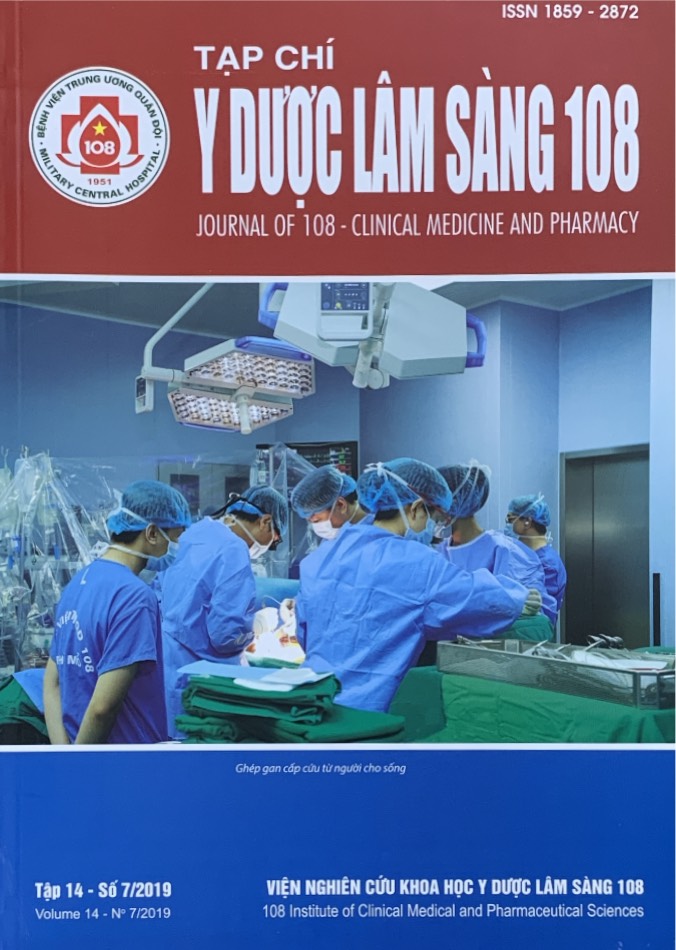Recrudescence or reinfection of H. pylori of duodenal ulcer patients after eradication in E Hospital
Main Article Content
Keywords
Abstract
Objective: The aim of this study is to differantiate recrudescence from reinfection H. pylori after eradication therapy in duodenal ulcer. Subject and method: After successful eradication of H. pylori, 303 patients were followed up by endoscopy and rapid urease test. In recurrent patients, H. pylori strains isolated initially and after recurrence were compared using PCR-based restriction fragment length polymorphism (RFLP) analysis. Result: Recurrence of H. pylori occurred in 20 of 52 patients (38.5%) at follow-up time from 6 months to 31 months. PCR-based RFLP analysis of H. pylori strains isolated initially and after recurrence showed that 27.8% of bacteria were the same strains (Recrudescence) and 72.2% were different strains (reinfection). Conclusion: The rate of reinfection higher than recrudescence make the clinicians and community to have activities to control H. pylori transmission sources beside effective eradication therapy.
Article Details
References
2. Gisbert JP (2005) The recurrence of Helicobacter pylori infection: Incidence and variables influencing it. A critical review. Am J Gastroenterol 100: 2083-2099.
3. Hildebrand P, Rossi L, Bardhan P et al (2001) Recrudescence and reinfection with Helicobacter pylori after eradication therapy in Bangladeshi adults. Gastroenterology 121(4): 792-798.
4. Hyun JJ, Kim SY, Jung SW, Koo JS, Yim HJ, Lee SW (2014) Helicobacter pylori recurrence after first- and second-line eradication therapy in Korea: The problem of recrudescence or reinfection. Helicobacter 19(3): 202-206.
5. Tadayoshi O, Ryugo S, Kazunari M, Hajime M, Masaru N, Jiro K, Masaaki K and Toshio Fu (2003) Is the recurrence of Helicobacter pylori infection after eradication therapy resultant from recrudescence or reinfection, in Japan. Helicobacter 8: 186-191.
6. Wheeldon T U, Hoang TT, Phung DC, Bjorkman A, Granstrom M, Sorberg M (2005) Long-term follow-up of Helicobacter pylori eradication therapy in Vietnam: Reinfection and clinical outcome. Aliment Pharmacol Ther 21(8): 1047-1053.
7. Rollan A, Fuster F, Giancaspero R et al (2000) The long-term reinfection rate and the course of duodenal ulcer disease after eradication of Helicobacter pylori in a developing country. Am J Gastroenterol 95(1): 50-56.
8. Bell GD, Powell KU (1996) Helicobacter pylori reinfection after apparent eradication the Ipswich experience. Scand J Gastroenterol 215: 96-104.
9. Ryu KH, Yi SY, Na YJ, Baik SJ, Yoon SJ, Jung HS, Song HJ (2010) Reinfection rate and endoscopic changes after successful eradication of Helicobacter pylori. World J Gastroenterol 16(2): 251-255.
10. Jorgensen M, Daskalopoulos G, Warburton V, Mitchell HM, Hazell SL (1996) Multiple strain colonization and metronidazole resistance in Helicobacter pylori-infected patients: Identification from sequential and multiple biopsy specimens. J Infect Dis 174(3): 631-635.
 ISSN: 1859 - 2872
ISSN: 1859 - 2872
